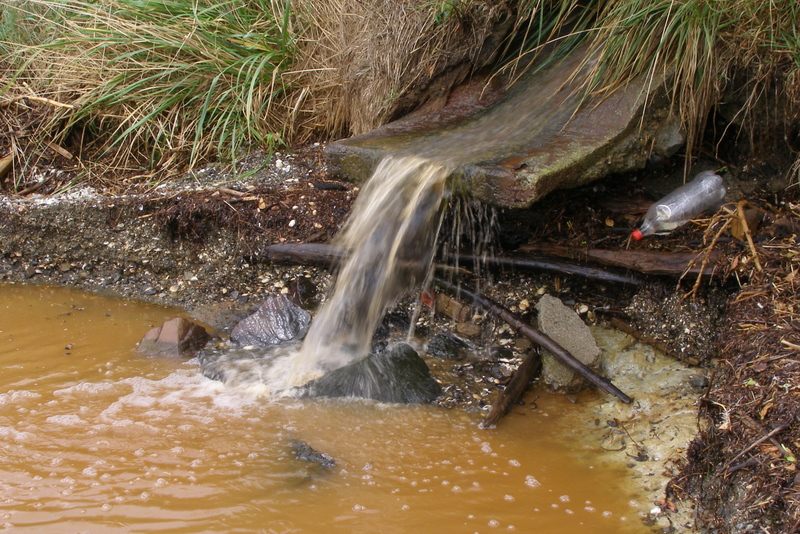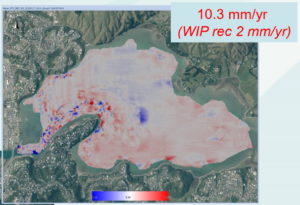Threats to the Inlet
The ecology of Pāuatahanui Inlet is under threat from three primary sources – sedimentation, contamination and eutrophication (the increasing concentration of plant nutrients in a body of water). A fourth threat may yet come from local effects of climate change, which could include a rise in sea level, more rainfall and increasingly frequent and/or severe storms.
A lot of the problems affecting the Inlet are due to the urbanisation of the southern and western end of the Inlet. GOPI is pleased to note that PCC, in its 30-year vision document, the Porirua District Plan, does not envision further large scale urban development of the Pāuatahanui Inlet basin, although some light industrial development may occur as a consequence of the newly opened Transmission Gully Motorway.
Here we review the origin and likely repercussions of each of the threats.

Sedimentation
The infilling of estuaries with sediment derived from erosion of catchment land is a natural process that has taken place over thousands of years. However, the rate at which it occurs in the Inlet has been radically increased by human activity. Research has shown that, before humans arrived in the area, sediment was accumulating in the Inlet at a rate of about 1 mm/year. This rate of infill however more than doubled between 1850 and 1950 as the original forested land was converted to pasture. During 1950-1985, a period when earthworks associated with urban development were ineffectively controlled, the rate at least trebled and a bathymetric survey in 2014 estimated that during 1974-2009 the rate was between 3 and 9mm/yr in different parts of the Inlet. The most recent bathymetric survey in 2019 estimated the sedimentation rate to have reached 10mm/yr. It is probable that some of the increase is due to the building of the Mana marina and the consequent transport of displaced sand into the Inlet. The greatest effect of this sand transportation was an increase in the size and location of the central sand bank. This in turn resulted in a reduction of the natural flushing of fine sediment by the outgoing tide from the north-western part of the Inlet. The 2019 estimate may also reflect the dumping of a large sediment load from the catchment due to the storm of November 2016. It is thought that this storm had the effect of cutting the population of cockles as measured by the 2016 survey of the species which took place two weeks later.
As sediment builds up, the intertidal and saltmarsh areas increase slowly and the deeper parts of the Inlet become shallower. Of more immediate concern for Inlet ecology is that the increased amount of fine sand and mud in the water reduces its clarity and the ability of seagrass and algae to photosynthesise and grow. Increased fine sediment also reduces the feeding efficiency of cockles and other filter-feeding animals and lays down more mud on the surface of the sand. From a human perspective there is a general shift towards an increase in less desirable species, such as mud snails, and a less visually attractive aspect at low tide – and one that may smell a bit too.
Research into sedimentation
Ongoing research of the Inlet is continuing into different aspects of the effects of sedimentation. These studies include:

A 2009 bathymetric survey of Porirua harbour that established the contours of the whole harbour, including the Pāuatahanui Inlet (see image left). This precise information about the depth of the Inlet allows accurate monitoring of future changes caused by sedimentation.
A 2012 report on the effects that dredging was likely to have on the hydrodynamics of the Inlet and thus on the flushing out of fine sediment. This report did not find a clear argument in favour of either extending the main channel or dredging the existing channels in the north-west of the Inlet.
A 2014 bathymetric survey established the likely rate of sedimentation occurring in different parts of the Inlet with an overall estimation of the rate based on the 2009 survey measurements.
A 2019 bathymetric survey crucially established that the rate of sedimentation was not slowing down and that storm events were having a significant effect on the seafloor and vegetation cover.
Contamination
The Inlet is subject to contamination from three sources: rubbish accumulating on the shore; waterborne contaminants in stormwater; chemicals derived from vehicles on roads around the Inlet and building materials used in the surrounding urban developments. The first of these, rubbish piled up on the shore, is unsightly but easily dealt with. GOPI has an annual Inlet Clean-up day and encourages local residents to adopt a patch of shore.
Contaminants in stormwater
There are 34 stormwater outlets into the Inlet, 13 into Browns Bay alone. A great deal of stormwater from urban hard surfaces (roofs, paths, roads, car parks, etc.) drains into the Inlet, either through these outlets or via urban streams.
Stormwater carries soluble contaminants such as phosphates from detergents used for washing cars and zinc from galvanised iron roofs and other structures. Phosphates are plant nutrients and contribute to eutrophication. Zinc is poisonous to animals and in its soluble form is easily taken up by filter feeding animals such as cockles.
Stormwater also carries sediment and particles of rubbish that contribute to sedimentation of the Inlet. Zinc and other heavy metals can chemically bind to these particles and thus build up the concentration of these poisons in the Inlet. These pose a threat to mud and sand-dwelling animals such as worms, and eventually to fish and birds higher in the food chain.
A further source of contamination from stormwater can be seepage from nearby sewerage systems. None of these sources of contamination need be a problem. They can all be filtered through artificial filters. Installing and maintaining such filters is, however, expensive and they have not been installed in the Inlet. Grass swales (drainage channels designed to manage water runoff) and water gardens act as natural filters, and are preferable to artificial systems, but these too are missing from the Inlet catchment.
Vehicle related contamination
The Inlet is ringed by roads for 75% of its shores. Rain on road surfaces washes the accumulated dust from vehicle brake pads and tyre wear into the Inlet. These substances contain metallic compounds of zinc, copper and cadmium, sooty residues from partially burnt petrol and diesel, and unburnt hydrocarbons from fuel and oil spillages.
These are all serious pollutants. They adversely affect the biology of many estuarine plants and animals. Particularly vulnerable are predatory species at the top of the food chain, including humans, when eating large numbers of polluted prey.
As with stormwater, all these pollutants can be filtered through grassed ‘swales’. A swale between the road and the Inlet can also act as a pedestrian pathway.
Because of the pollution threat from the surrounding traffic-dense roads, GOPI supported the building of Transmission Gully, with the hope that it would take away most of the traffic between Kapiti and the Hutt Valley that used both the Paremata-Pāuatahanui highway and Grays Road (see Roading Policy .
The Porirua Harbour Accord
In February 2025 the new Porirua Harbour Accord superseded the earlier Porirua Harbour Strategy and Action Plan, published in June 2015. Like the old strategy, which failed in its intent, the new Accord aims to reduce both sedimentation and contamination from the multiple sources of pollution that damage the ‘cultural, aesthetic and recreational values’ of the harbour and includes both the Pāuatahanui Inlet and the Onepoto Arm of Te Awarua o Porirua.
Eutrophication
Eutrophication, the increasing concentration of plant nutrients in a body of water, would obviously increase algae and seagrass growth. If the eutrophication process is continuous, in the long term the quicker growing algae, especially the bright green sea lettuce, will end up smothering the seagrass and depriving the surface layers of the sand banks of oxygen. This oxygen deprivation would lead to the death of much of the bottom dwelling fauna. Moreover, the algae that respond most quickly, like the sea lettuce, are not desirable food for herbivorous birds and animals. The Inlet and its intertidal banks would become covered with a slimy and evil smelling ankle-deep mess of live and decaying algae.
The nutrients, mostly those high in nitrogen or phosphorus, derive mainly from agricultural fertilisers in the catchment and effluent from stock, with some input from poorly designed or maintained septic tanks and urban sewerage systems. Luckily, the stock component in the Inlet catchment is minor and can be minimised by keeping stock away from stream edges. Leaching of fertiliser from soil is more difficult to control but intelligent revegetation practices, such as those advocated by the Pāuatahanui Vegetation Framework can be very helpful.
Climate Change
The effects of climate change on the Inlet are an unpredictable and serious long-term concern.
-
- The predicted increase in annual rainfall and in frequency of severe rain storms could increase erosion in the catchment, and thus sedimentation of the Inlet. Storms, such as the one in November 2016, demonstrate this future likelihood.
- A rise in water temperature would accelerate the rate of eutrophication.
- Even a small rise in sea level would impact heavily on the Wildlife Reserve and its breeding birds and would cause transport difficulties along SH 58 and Grays Road.
- The predicted increase in annual rainfall and in frequency of severe rain storms could increase erosion in the catchment, and thus sedimentation of the Inlet. Storms, such as the one in November 2016, demonstrate this future likelihood.